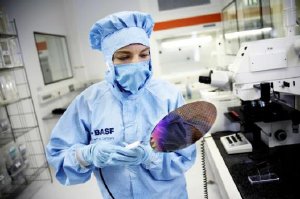BASF has created an advanced copper plating chemistry for current and future generation chip technologies. The innovative chemical solution, which is the direct result of the joint development program with IBM started in June 2007, outperforms other commercially available chemistries.

The two companies are extending their cooperation on setting the parameters for mass production. The related technology, chemicals and materials are expected to be commercialized in mid 2010.
"We are very excited about this innovative chemistry. The IBM-BASF team has chosen a new approach of using the understanding of the mechanism of copper deposition to design molecular additive systems," said Dr. Dieter Mayer, Senior Manager, Development of BASF's business unit Electronic Materials as well as the project leader. "With the strong resources from BASF and IBM, we have tackled major challenges in copper plating and have moved closer to producing smaller, faster, and more reliable chips."
Achieving defect-free conductor lines is the most critical requirement for a successful copper deposition process. Traditional conformal fill in copper plating has a uniform copper deposition rate on top, bottom and sidewalls of the feature, resulting in seams and defects. BASF chemistry gives fast fill or what is widely known as "superfill" which fills very small trenches and vias with copper and produces defect-free lines. With superfill, the rate of copper deposition is higher at the bottom than on the top and on the sidewalls.
Copper wiring significantly improves the performance of a chip and the deposition of this highly conductive metal is a critical process in building the multilevel interconnect structures. Today's state-of-the-art chip technology is known as the 32-nanometer (nm) technology node and the next generation 22-nanometer technology is expected to be introduced in 2011. The making of high performance chips requires specific chemical knowledge, as the dimensions become smaller, the more complex the interconnect structures become, and highly sophisticated chemical processing solutions are needed.
The copper plating chemistry can be applied in both 32- and 22-nanometer chip technology and significantly improves the reliability of on chip copper wiring and increases the performance and quality of chips.